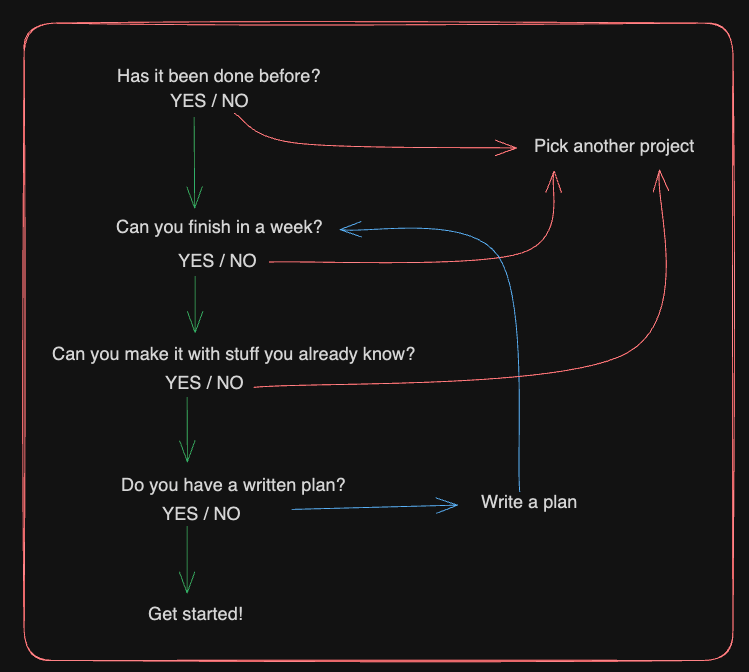As an enthusiast and advocate for skill development through project building, I find immense value in sharing insights on how to approach project-based learning effectively. In my recent exploration, I've delved into methodologies that can significantly enhance the learning curve for aspiring engineers and developers, especially those venturing into the vast world of technology and programming through bootcamps like Concordia.
Table of Contents
The Essence of Choosing the Right Project

Choosing the right project is pivotal. It's not just about selecting something that sparks interest but also about ensuring it's a feasible challenge. A project that hasn't been done before might seem appealing for its novelty, but it's often a red flag. The absence of a precedent usually indicates a high likelihood of encountering insurmountable obstacles, leading to frustration and potentially, abandonment of the project. The key is to select projects that are achievable within a reasonable timeframe, ideally within a week if dedicating full-time hours. This approach ensures a balance between challenge and achievability, preventing the all-too-common pitfall of project abandonment due to unrealistic ambitions.
The Planning Phase: A Blueprint for Success
Diving into code without a solid plan is akin to navigating uncharted waters without a map. The planning phase is crucial, demanding an abstraction level that encompasses the entire project scope. For instance, envisioning a web app for a book club requires breaking down the project into manageable tasks, identifying potential problems within problems, and methodically planning each feature. This detailed planning phase transforms an overwhelming project into a series of achievable tasks, each with its unique set of requirements and solutions.
Breaking Down the Project into Tasks
The granularity of planning should extend to creating specific tasks or "tickets" that outline each feature's requirements. For example, implementing an autocomplete feature involves understanding the intricacies of user input processing, string comparison, sorting, and presenting results. Each aspect requires careful consideration and planning, ensuring that when the coding phase begins, the focus is solely on execution rather than problem-solving on the fly.
Time Estimation and Prioritization
Estimating the time each task will take is more art than science, prone to inaccuracies. However, assigning effort points to tasks, based on a scale of complexity, can help in prioritizing and scheduling work. This method, often employed in agile methodologies, facilitates a more organized approach to project execution, enabling a realistic assessment of what can be accomplished within a given timeframe.

Learning through Mini Projects
For skills or technologies that are new, I advocate for undertaking mini projects focused solely on mastering that particular element. This approach not only solidifies understanding but also provides a tangible reference for future projects. Documenting and sharing these learning experiences further cements knowledge and offers a valuable resource for revisiting when needed.
Collaboration and Open Source Contribution
Collaborating with others, whether through open source projects or joint ventures, is invaluable. It exposes one to diverse coding practices and problem-solving techniques, enhancing adaptability and teamwork skills. Moreover, it's a practical way to accelerate learning and project development, benefiting from collective expertise and feedback.
Continuous Learning and Documentation
The cycle of planning, executing, documenting, and sharing should be continuous. Each project, whether a personal endeavor or a collaborative effort, contributes to a portfolio that showcases skill development over time. This iterative process of learning, building, and contributing not only enhances technical skills but also fosters a mindset geared towards continuous improvement and sharing knowledge with the broader community.
Embarking on this journey of project-based learning, grounded in careful planning, realistic goal setting, and collaborative engagement, offers a structured yet flexible framework for skill development. It's a path that I, as an author and developer, have found to be both rewarding and effective in navigating the ever-evolving landscape of technology.
Translating skills
As I continue my journey in the tech industry, I've become more intrigued by the idea of transitioning my skills from familiar technologies to new ones. It's not merely about acquiring new knowledge; it's about understanding how to leverage my existing skills in a new context. This exploration began when I decided to venture into Go, coming from a strong background in Node.js and Express.
I discovered that transitioning skills isn't about starting from scratch but rather about translating what you know into a new language or framework. For instance, learning about Gin in Go, I realized it served a similar purpose to Express in Node.js. This realization was enlightening—it showed me that I could grasp about 60% of the new framework based on my prior knowledge. The key was to identify parallels and differences, then bridge the gaps in understanding.
This approach isn't just about technical translation; it's a strategy for risk management. By focusing on a small, manageable part of the new technology—like replacing Express.js with Gin in a project—the risk of becoming overwhelmed is minimized. It's about biting off what you can chew and gradually integrating new knowledge into your existing framework.
The process taught me a valuable lesson: learning a new technology or language should be approached in small increments, as a side skill, rather than trying to overhaul your entire skill set at once. This method allows you to build confidence and competence in the new area without jeopardizing your current projects or spreading yourself too thin.
Final Thoughts
In conclusion, the path to becoming a versatile and skilled tech professional is paved with continuous learning and experimentation. By embracing a diverse set of technologies and not shying away from challenges, I'm paving the way for a fulfilling and dynamic career in tech. The journey is ongoing, but with each project and each new skill, I'm becoming more adaptable, knowledgeable, and prepared for whatever comes my way.